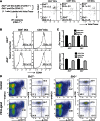EBI2-mediated bridging channel positioning supports splenic dendritic cell homeostasis and particulate antigen capture
- PMID: 23682316
- PMCID: PMC3654440
- DOI: 10.7554/eLife.00757
EBI2-mediated bridging channel positioning supports splenic dendritic cell homeostasis and particulate antigen capture
Abstract
Splenic dendritic cells (DCs) present blood-borne antigens to lymphocytes to promote T cell and antibody responses. The cues involved in positioning DCs in areas of antigen exposure in the spleen are undefined. Here we show that CD4(+) DCs highly express EBI2 and migrate to its oxysterol ligand, 7α,25-OHC. In mice lacking EBI2 or the enzymes needed for generating normal distributions of 7α,25-OHC, CD4(+) DCs are reduced in frequency and the remaining cells fail to situate in marginal zone bridging channels. The CD4(+) DC deficiency can be rescued by LTβR agonism. EBI2-mediated positioning in bridging channels promotes DC encounter with blood-borne particulate antigen. Upon exposure to antigen, CD4(+) DCs move rapidly to the T-B zone interface and promote induction of helper T cell and antibody responses. These findings establish an essential role for EBI2 in CD4(+) DC positioning and homeostasis and in facilitating capture and presentation of blood-borne particulate antigens. DOI:http://dx.doi.org/10.7554/eLife.00757.001.
Keywords: Dendritic cells; EBI2; Mouse; Oxysterols; antigen capture; lymphotoxin; spleen bridging channel.
Conflict of interest statement
The authors declare that no competing interests exist.
Figures













References
Publication types
MeSH terms
Substances
Grants and funding
LinkOut - more resources
Full Text Sources
Other Literature Sources
Molecular Biology Databases
Research Materials

